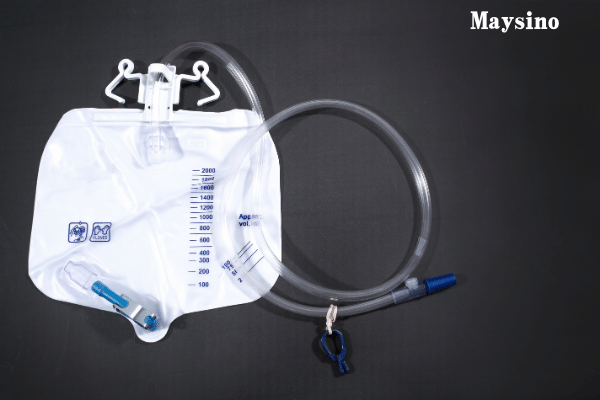Should I disinfect the urinary leg bag opening? Let's talk about the confusion of urine bags.
2021-04-07
A urine bag is a sterile plastic bag for collecting urine.
Indwelling catheterization is one of the most common and frequently applied nursing operations in order to accurately record urine volume and solve the patient's difficulty in urination, and the urine collection bag is a necessary item for indwelling catheterization and needs to be changed regularly.
When a patient with indwelling catheterization has finished emptying the urine in the bag, should the bag's mouth be routinely disinfected? How can I prevent urinary tract infections in people with long-term indwelling catheterization?
To avoid urinary tract infections, there are many details to pay attention to. In response to these questions, expert advice is that sterilization is generally unnecessary, but who should replace the catheter immediately if the sterility and tightness of the indwelling catheterization device are compromised, when a patient develops a urinary tract infection, what should replace the catheter promptly, and what should retain urine for microbiologic pathogenic testing.
Urine leg bag discharge, except for special departments such as ICU and operating room, operated by nursing staff, is overwhelmingly performed by escorts in inpatients.

In addition to whether the urine bag opening needs to be disinfected, do you have any confusion about the following issues?
No.1
When to empty the urine bag?
The 2014 NHS Hospitals in England - Evidence-Based Guidelines for the Prevention of Hospital Acquired Infections recommends that
① Do not allow the urine in the Urine leg bag to exceed 3/4 of its capacity.
② Also, the transfer process may cause reflux of urine, and therefore the drainage bag should be emptied before transfer.
Reason for a recommendation.
Pathogenic microorganisms can cause infection via the intraluminal route of the catheter or the extraluminal route. Intraluminal infections are mainly caused by retrograde invasion of pathogenic microorganisms when the drainage system's containment is broken, most commonly through the end of the catheter, the connector of the drainage tube connected to the ureter, and the drainage port of the urine bag. If the drainage system is open when urine is discharged, it may cause contamination, and the probability of contamination is increased significantly by frequent urination; if the Urine leg bag is contaminated at the discharge port inappropriately, the pathogens may enter the urinary tract directly through the discharge port and cause infection. On the other hand, if the Urine leg bag is overfilled by not emptying the urine in time, it may cause poor drainage and increase the risk of CAUTI.
No.2
How to empty the urine bag?
When emptying the Urine leg bag, the operation's focus is to avoid contamination of the outlet of the bag. If the bag's outlet is contaminated, pathogens can retrograde from the outlet to the urinary tract causing infection. Therefore, when operating, what should follow these principles.
① Avoid contact between the Urine leg bag and the ground.
② avoid direct contact between the outlet of the Urine leg bag and the non-sterile collection container.
③If the outlet of the drainage bag will not touch other objects; disinfection may not be carried out.
④If the Urine leg bag has an outlet protection cap after the urine is emptied, the drainage bag's outlet and the protection cap should be disinfected before returning to the set.
⑤ Also, to avoid contamination of medical staff's hands when pouring urine, what should wear clean gloves, and what should change gloves between patients.
Source of evidence.
The Technical Guidelines for Prevention and Control of Catheter-Associated Urinary Tract Infections (for Trial Implementation) issued by the General Office of the Ministry of Health in 2010 clearly states that when emptying urine from the collection bag, what should follow the principle of aseptic operation and the outlet of the collection bag should be avoided from touching the collection container.
The Prevention Strategy for Catheter-Associated Urinary Tract Infections in Healthcare Facilities (2014 Edition) also clearly states that the drainage outlet should avoid touching the collection container when emptying the urine in the Urine leg bag (Evidence Level III).
After reading the above points, you should know the answer to whether the Urine leg bag outlet needs to be disinfected or not.
No.3
What are the requirements for the urine collection container inside the Urine leg bag?
Recommendation: There is a consensus to use a personal collection container to empty the urine in the Urine leg bag on time.
The reasons are as follows: sharing collection containers among multiple people can lead to contamination of other patients' urine bags by pathogenic microorganisms by hand or other means. If the urinary collection bag is contaminated, pathogens can enter the urinary tract directly through the urinary outlet and cause infection.
Source of Evidence.
Technical Guidelines for the Prevention and Control of Catheter-Associated Urinary Tract Infections (Trial), issued by the General Office of the Ministry of Health in 2010, clearly states that the urine in the Urine leg bag should be emptied promptly using a personalized collection container.
The 2014 edition of the Chinese Guidelines for the Diagnosis and Treatment of Urological Diseases also states timely emptying of urine in the Urine leg bag using a personally dedicated collection container (recommended grade IB).
No.4
When to change the Urine leg bag?
There is a lack of uniform standards regarding the replacement interval of drainage devices, both at home and abroad.
Some studies have shown that it is appropriate to replace the unidirectional flap Urine leg bag once a week and the ordinary sterile Urine leg bag twice a week. However, the sample size of relevant domestic studies is small, and the quality of literature is low, so the reference value is not high.
Routine replacement of drainage devices is not recommended abroad. Avoiding frequent replacement of Urine leg bags can reduce the probability of opening catheter and urinary collection system confinement, reduce the medical cost of patients and reduce the workload of nursing staff. Therefore, routine replacement of Urine leg bags is not supported, and the specific replacement intervals refer to the instructions.
Domestic and international consensus on indications for drainage device replacement is
Maintenance of a sterile, continuously closed drainage system. The moment sterility is broken, disconnection at the joint, or leakage of urine occurs, the catheter and drainage device should be replaced using aseptic methods.
The Urine leg bag should be replaced immediately in infection, blockage of the Urine leg bag, or poor containment.
Maysino is a manufacturer of Urinary Leg Bags, and we have been paying close attention to the positive impact that the proper use of medical products can have on our patients' health. We are also happy to share ideas with you. Click to learn more about our products that may be of help to you.

